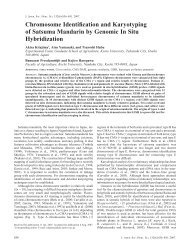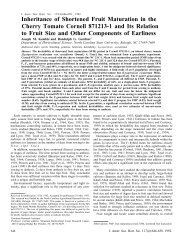Consumer Tastes, Preferences, and Behavior in Purchasing Fresh ...
Consumer Tastes, Preferences, and Behavior in Purchasing Fresh ...
Consumer Tastes, Preferences, and Behavior in Purchasing Fresh ...
You also want an ePaper? Increase the reach of your titles
YUMPU automatically turns print PDFs into web optimized ePapers that Google loves.
equation, suggest<strong>in</strong>g that price does impact on quantity dem<strong>and</strong>ed.<br />
The coefficients of price suggest that price has less of an impact on<br />
quantity purchased of Jersey <strong>Fresh</strong> tomatoes than on other tomatoes.<br />
Actual behavior is a more accurate measure of the effect of<br />
price on quantity dem<strong>and</strong>ed than is the result of the perception<br />
question. In addition, the questions about prices of tomatoes did<br />
not take <strong>in</strong>to account magnitude of price changes.<br />
Color was not significant <strong>in</strong> Eq. [2]. This may <strong>in</strong>dicate that color<br />
means different th<strong>in</strong>gs to different consumer groups. Many consumers<br />
recognize tomatoes with some green or p<strong>in</strong>k coloration as<br />
v<strong>in</strong>e-ripened tomatoes <strong>and</strong> consider this attribute an <strong>in</strong>dication of<br />
good flavor. However, as consumers become several generations<br />
removed from agriculture <strong>and</strong> do not have experience with produc<strong>in</strong>g<br />
tomatoes <strong>in</strong> home gardens, they often are not familiar with<br />
natural ripen<strong>in</strong>g, <strong>and</strong> prefer the more uniform color of gassed<br />
tomatoes. In this survey, 63.7% of the respondents never obta<strong>in</strong><br />
tomatoes from home gardens. Some varieties sold <strong>in</strong> New Jersey<br />
do not have a uniform ripen<strong>in</strong>g gene <strong>and</strong> have green shoulders <strong>in</strong><br />
the store if they are displayed before they are completely red.<br />
<strong>Consumer</strong>s may f<strong>in</strong>d this unattractive. However, many people who<br />
felt that Jersey <strong>Fresh</strong> was better overall, commented that Jersey<br />
<strong>Fresh</strong> tomatoes are the “ugly tomato that tastes good.” These<br />
people may not consider color to be important to their purchase<br />
decision or they may consider the uneven color<strong>in</strong>g a preferred trait.<br />
Color can be important to purchasers of Jersey <strong>Fresh</strong> tomatoes <strong>and</strong><br />
other tomatoes for different reasons, mak<strong>in</strong>g it a nonsignificant<br />
variable <strong>in</strong> the dem<strong>and</strong> function.<br />
Most consumers use color as an <strong>in</strong>dication of ripeness at the<br />
time of purchase. Many consumers feel the uniform color of gassed<br />
tomatoes <strong>in</strong>dicates ripeness, while others look for the depth of red<br />
coloration on v<strong>in</strong>e-ripened, locally grown tomatoes as an <strong>in</strong>dication<br />
of ripeness. Thus, the differences <strong>in</strong> perception of color among<br />
consumers similarly apply to degree of ripeness.<br />
Historically, medium tomatoes (5.7 cm to 6.4 cm <strong>in</strong> diameter)<br />
have returned much less revenue by weight to New Jersey farmers<br />
than the large tomatoes associated with New Jersey. Size was not<br />
a significant variable. Sixty percent of the people surveyed preferred<br />
medium-sized tomatoes <strong>and</strong> only 34% preferred large, a<br />
possible <strong>in</strong>dication that growers may receive a high price for<br />
medium tomatoes as well as large tomatoes traditionally associated<br />
with New Jersey.<br />
The only taste <strong>and</strong> preference variables that were <strong>in</strong>cluded <strong>in</strong> the<br />
f<strong>in</strong>al dem<strong>and</strong> equation were orig<strong>in</strong> <strong>and</strong> overall quality. Significance<br />
of the overall variable <strong>in</strong>dicated a preference for Jersey <strong>Fresh</strong><br />
tomatoes that was l<strong>in</strong>ked to the attributes of the tomato itself. The<br />
coefficient of the overall variable was negative <strong>and</strong> significant for<br />
other tomatoes, <strong>in</strong>dicat<strong>in</strong>g that respondents who said Jersey <strong>Fresh</strong><br />
tomatoes were better than other tomatoes overall purchased more<br />
Jersey <strong>Fresh</strong> tomatoes than other tomatoes.<br />
The nonsignificance of other taste <strong>and</strong> preference variables<br />
when these are <strong>in</strong>cluded <strong>in</strong> the dem<strong>and</strong> equation may also be<br />
expla<strong>in</strong>ed on the basis that dem<strong>and</strong> for Jersey <strong>Fresh</strong> Premium <strong>and</strong><br />
st<strong>and</strong>ard tomatoes was comb<strong>in</strong>ed <strong>in</strong> the same equation (aggregation<br />
error). K<strong>in</strong>gs Super Markets was not will<strong>in</strong>g to vary the price<br />
of the Jersey <strong>Fresh</strong> st<strong>and</strong>ard tomatoes dur<strong>in</strong>g the course of the<br />
survey. As a result, separate dem<strong>and</strong> equations for st<strong>and</strong>ard <strong>and</strong><br />
premium tomatoes were not obta<strong>in</strong>ed because price variability was<br />
needed to test the effect of price on dem<strong>and</strong>. This may be a<br />
significant limitation of this study. Fifty-six percent of respondents<br />
had been disappo<strong>in</strong>ted with past purchases of fresh tomatoes, but<br />
s<strong>in</strong>ce 44% had not been disappo<strong>in</strong>ted; comb<strong>in</strong><strong>in</strong>g both groups of<br />
J. Amer. Soc. Hort. Sci. 118(3):433-438. 1993.<br />
respondents resulted <strong>in</strong> aggregation error where differences that<br />
might be significant <strong>in</strong> <strong>in</strong>dividual equations were lost.<br />
Intercept. The <strong>in</strong>tercept for Jersey <strong>Fresh</strong> tomatoes was larger<br />
than that obta<strong>in</strong>ed for other tomatoes, <strong>in</strong>dicat<strong>in</strong>g a general New<br />
Jersey consumer preference for Jersey <strong>Fresh</strong> tomatoes. The difference<br />
<strong>in</strong> the <strong>in</strong>tercepts captures the additional dem<strong>and</strong> for Jersey<br />
<strong>Fresh</strong> tomatoes not expla<strong>in</strong>ed by the other variables <strong>in</strong> the dem<strong>and</strong><br />
function (Rosen, 1974). The f<strong>in</strong>d<strong>in</strong>gs are consistent with earlier<br />
research that suggests consumers are will<strong>in</strong>g to pay a premium for<br />
locally grown tomatoes that are considered to be fresher than<br />
tomatoes from distant markets (Brooker et al., 1987; 1988), <strong>and</strong><br />
that they are more likely to purchase a higher quality product when<br />
prices are ris<strong>in</strong>g.<br />
Conclusions. Jersey <strong>Fresh</strong> tomatoes had a lower own-price<br />
elasticity, higher <strong>in</strong>come elasticity, <strong>and</strong> lower cross-price elasticity<br />
than other tomatoes, all of which <strong>in</strong>dicate that Jersey <strong>Fresh</strong><br />
tomatoes are considered to be a superior, differentiated product.<br />
Overall, consumers ranked Jersey <strong>Fresh</strong> above other tomatoes <strong>and</strong><br />
favored them because of their orig<strong>in</strong>. F<strong>in</strong>d<strong>in</strong>gs suggest that local<br />
New Jersey-grown tomatoes should be promoted under the Jersey<br />
<strong>Fresh</strong> logo as v<strong>in</strong>e-ripened tomatoes of local orig<strong>in</strong> that are better<br />
than other tomatoes. The scope of this work did not permit test<strong>in</strong>g<br />
whether this f<strong>in</strong>d<strong>in</strong>g would apply to locally grown tomatoes <strong>in</strong><br />
other areas of production. Flavor, freshness, <strong>and</strong> nutrition should<br />
also be promoted because these were all significant <strong>in</strong> the dem<strong>and</strong><br />
equation when added one at a time. Higher priced premium<br />
tomatoes should also be promoted based on these three factors but,<br />
<strong>in</strong> addition, should be targeted to high-<strong>in</strong>come consumers for<br />
whom uniformity of size <strong>and</strong> color, better appearance, <strong>and</strong> lack of<br />
blemishes is important.<br />
<strong>Consumer</strong>s are will<strong>in</strong>g to pay a premium for Jersey <strong>Fresh</strong><br />
tomatoes. From the producer’s po<strong>in</strong>t of view, a price premium is<br />
necessary if they are to market Jersey <strong>Fresh</strong> Premium tomatoes<br />
because of additional grad<strong>in</strong>g <strong>and</strong> packag<strong>in</strong>g costs of these premium<br />
tomatoes. In an urbanized environment such as New Jersey,<br />
upper-<strong>in</strong>come consumers tend not to have home gardens <strong>and</strong> are<br />
not familiar with truly v<strong>in</strong>e-ripened tomatoes. Only 36% of respondents<br />
<strong>in</strong>dicated that they obta<strong>in</strong> tomatoes from home gardens.<br />
Promotion should <strong>in</strong>clude educat<strong>in</strong>g consumers about the appearance<br />
<strong>and</strong> superior flavor of v<strong>in</strong>e-ripened tomatoes.<br />
S<strong>in</strong>ce consumers perceive Jersey <strong>Fresh</strong> tomatoes to be a better<br />
tomato overall (attribute preference), <strong>in</strong> addition to preferr<strong>in</strong>g<br />
tomatoes of local orig<strong>in</strong> (nonattribute preference), improvements<br />
<strong>in</strong> the quality <strong>and</strong> the appearance of the tomatoes themselves<br />
should cont<strong>in</strong>ue to be made. Varieties <strong>and</strong> production techniques<br />
that will reduce the problem of green shoulders, nonuniformity,<br />
<strong>and</strong> blemishes should be selected for <strong>and</strong> developed further. Us<strong>in</strong>g<br />
uniform ripen<strong>in</strong>g tomato varieties would elim<strong>in</strong>ate the problem of<br />
green shoulders, <strong>and</strong> <strong>in</strong>creased adoption of trellis<strong>in</strong>g <strong>and</strong> more<br />
careful grad<strong>in</strong>g would help reduce blemishes <strong>and</strong> <strong>in</strong>crease uniformity.<br />
Although this study focuses on New Jersey tomatoes, the<br />
f<strong>in</strong>d<strong>in</strong>gs may be relevant to other crops <strong>and</strong> other areas. Promotion<br />
of local produce has become more important <strong>in</strong> recent years as<br />
states attempt to ma<strong>in</strong>ta<strong>in</strong> <strong>and</strong> exp<strong>and</strong> their market shares. The<br />
importance of orig<strong>in</strong> <strong>in</strong> consumer purchas<strong>in</strong>g decisions suggests<br />
other states may be successful <strong>in</strong> promot<strong>in</strong>g local produce on the<br />
basis of orig<strong>in</strong> alone. Results also <strong>in</strong>dicate that product attributes<br />
are important. Thus, improvements <strong>in</strong> the produce should be made<br />
<strong>in</strong> addition to promot<strong>in</strong>g <strong>and</strong> br<strong>and</strong><strong>in</strong>g local produce. Otherwise, a<br />
state could f<strong>in</strong>d itself with produce that is highly visible but<br />
recognized for <strong>in</strong>ferior attributes.<br />
437
















